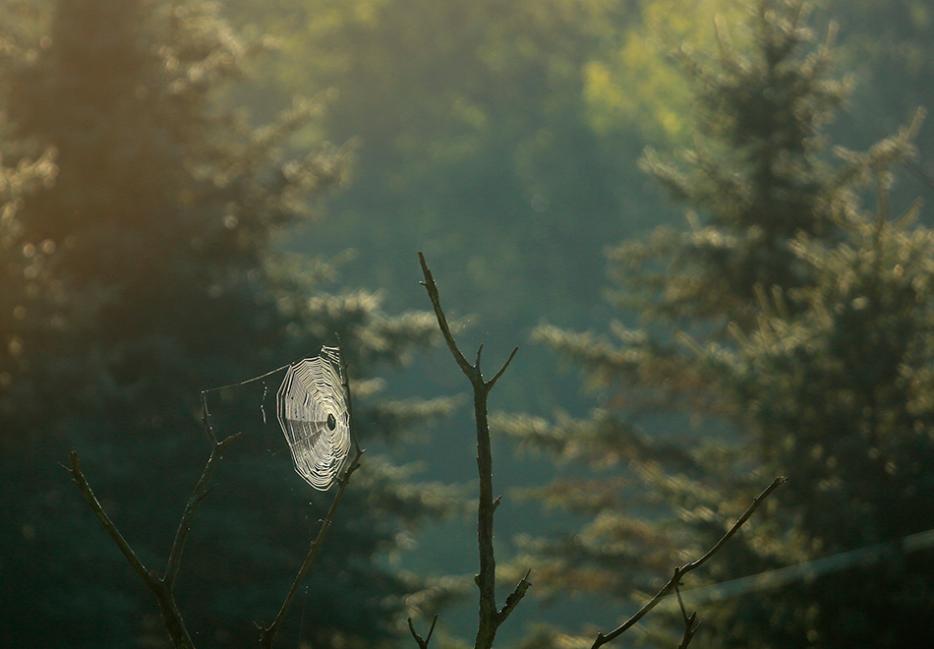On her way to give birth to me, my mother wore a light navy and white floral print dressing gown. It had belonged to my grandmother’s sister, who leant it to her for the occasion. At fifty, this sister wore it to plant cream orange rose bushes in her garden in the North of England; at thirty-one, my mother wore it to the hospital. Moving in blurs of leafy and wide-petal navy in her hugs, it is the first pattern I remember. Over forty years later, the gown found its way from my mother’s wardrobe to mine: its patterned sleeves are fraying slightly and half of the label is unattached, but it carries my story in meticulous invisible stitches—an embroidered lineage of maternity. At twenty, I took to wearing it whenever I was home alone in a string of university halls and London apartments. We select our different lives in the same gown; it travels quietly with us as we bundle it into suitcases, in different years, across the country.
In Rebecca Solnit’s The Faraway Nearby, a poignant narrative on motherhood and storytelling, she writes of women in fairy tales surviving on the art of weaving: Scheherazade prevents her death at the hands of her husband in One Thousand and One Nights by joining threads to form stories; the unnamed heroine in Rumpelstiltskin spins straw into gold. She writes, “by spinning, weaving, unravelling, these women master time itself, and though master is a masculine word, this mastery is feminine.” Solnit credits the heroine in Rumpelstiltskin with creating “form out of formlessness, continuity out of fragments, narrative and meaning out of scattered incidents, for the storyteller is also a spinner or weaver and a story is the thread that meanders through our lives to connect us.” Mirroring the complex Chinese-box structure of her book, Solnit taps into a series of intricate intersections: motherhood as stitching, motherhood as storytelling; stitching as storytelling and storytelling as stitching, an infinite circle of connection.
In her piece The Stitch Is Lost Unless The Thread Is Knotted (2008), British-Lebanese artist Aya Haidar stitched two small white dresses together with black threaded words. The dresses hang suspended from a washing line, clipped in place with wooden clothes pegs. Their sentences read from one dress to the other, trailing off in drooping lines of black thread before continuing the narrative. Haidar learned to sew as a child, and became enchanted by the female heritage of needlework—the process of handing a craft down through generations, just as we inherit our clothes. In an interview, she remarked that, “the element of craft, or the handmade, is also very important in my practice, not only from a personal perspective having learned to sew from my grandmother as she recounted stories of Lebanon, but also from a feminist dimension being that craft was the catalyst that projected women onto the expressionist stage. The labour, repetition and imperfection behind the stitch is one that I embrace.” Overlapping Haidar’s memory of stitching is a memory of storytelling— a storytelling of female history, coupled with a traditionally female craft, both holding their roots in her grandmother’s accounts of Lebanon—its history and the history of stitch woven with hers.
The text stitched onto the dresses is a poem a mother, a Somali refugee, wrote to her daughter, detailing her love. These stitches are the product of the needle’s movements: linear, fragmented, methodical and overlapping, much like the stories we inherit.
Just as Haidar’s grandmother told stories of her childhood over sewing, we are told our mothers’ stories through the fabrics they wear and pass to us: the bucket-shaped handbag my mother bought at twenty-one when she made a new life for herself in the city; the scratchy cardigans my grandmother knitted for herself after the war was over; the leaf-print dressing gown passed through three generations. Fragmented anecdotes unfold as we wear them. In a bright daisy-print dress, I watched my mother re-marry; in the same dress, I fell in love for the first time; these simultaneous histories stretch out across the fabric in palimpsests, a perpetual re-writing of life. To borrow your mother’s coat, or your best friend’s shirt, or your sister’s dress, is stitching your own story with theirs, an effort to connect, to draw them closer. It is an intimate coupling of female narrative in imperfect lines, a female mastery of storytelling through textile, stitching, weaving.
*
Women have long sewed histories into their clothes. Sonia Delaunay, a Ukraine-born French painter and textile artist, is well-known for her poem-dresses onto which she stitched the Surrealist poems of her contemporaries. In 1911 she stitched a blanket for her son, Charles, from different scraps of fabric. Couverture de berceau (crib quilt) is full of contrasting deep greens, pastel pinks and russets, arranged in a mismatched patchwork fashion, full of interlocking shapes and curved waves of material. It was made spontaneously, a melting pot of uneven squares and sloping rectangles—a rushed and imperfect expression of maternal adoration, creating form from formlessness and a whole from fragments. After finishing the quilt she continued practicing what was termed simultanéisme, a technique developed from the colour theories of Michel Eugène Chevreul, who published De la loi du contraste simultanée des couleurs (on the law of the simultaneous contrast of colours). Chevreul claimed that colours are perceived differently when positioned next to others and that the contrast enhances both. Sonia’s work became characterised by this simultaneous design, the overlapping and beautifully jarring colours of her paintings and fabrics; mosaics of dusty blues married to ochre and plum.
My father was an intelligent, violent and cruel man, and took to barring us from the other rooms of the house, and so the three of us spent most of our time in the kitchen, drawing or sewing at the table, filling the gaps in our own tapestries with fierce and unwavering sisterhood.
My grandmother started knitting when she was seven during the Second World War. Evacuated from Battersea in London to Devon with her mother, she knitted clothes for her doll with the thick, dull wool rationed to her. Years afterward, she worked from a pattern her mother had designed to knit a blanket for my mother when she was a child; like a woven basket, it was an overlapping grid of warm blues and pinks edged with a blue border. When I was born, my mother asked that she knit another blanket for me in the same pattern; mine was lemon yellow and white. Infused in each thread is a rhythmic enthusiasm, an unquiet maternal love from three generations of women taking physical form.
*
Of her towering spider sculpture Maman (1999), made of stainless steel, bronze and marble, French-American artist Louise Bourgeois remarked, “the Spider is an ode to my mother. She was my best friend. Like a spider, my mother was a weaver. My family was in the business of tapestry restoration, and my mother was in charge of the workshop.” Maman, resting on metaphors of mothering as weaving webs, stands on pointed arched legs and carries a meshed sac of seventeen marble eggs beneath its body. Allowing visitors to walk beneath, it is at once both protective and overwhelmingly intimidating in its scale.
Below their apartment in Choisy-le-Roi in a southern suburb of Paris, Bourgeois’ parents ran their tapestry restoration workshop, and as a child she drew templates for the frayed or missing sections that needed to be re-woven. She described her mother, Josephine, as intelligent, kind, her best friend; her father possessed a furious temper and dominated their household. When her mother died in 1932, Bourgeois was grief-stricken and gave up her study of mathematics to pursue art, which her father refused to support. At the École des Beaux-Arts, and for the rest of her career, she reflected on the experiences of her childhood and punctuated her art with motherhood and weaving in all their forms: the mother as spider is a central figure across her drawings, textiles and sculptures. In 1995, she created Ode à ma mère, a book consisting of etched, embossed and mono-print spiders; in the early 2000s, she completed a series of untitled woven fabric works, mirroring the spider weaving silk into glistening intricate patterns; The Fragile (2007), a series of deep red and royal blue dyes on fabric, depicted a series of naked women next to spiders, as spiders, with spider legs for limbs. Across the works are a strange and at times unsettling fascination with the art of weaving, inextricably linked to the art of motherhood.
Similarly to Delaunay’s crib quilt, Bourgeois too sewed scraps of material together in her fabric works, cutting and re-stitching bed linen, pillowcases and napkins in pastel pinks and faded pearls in meticulous squares, honouring her mother’s tradition of repair.
*
Just as to restore a tapestry is to connect with its history, an effort to prevent its fraying or disintegration, tapestry is a way to honour a feminine heritage of restoration, a way of catching our mothers’ histories before they fade. We carry, preserve and restore our mother’s stories in the way we treasure their blankets, their dressing gowns, their school books, restoring them when they become worn. In an interview, Bourgeois recalled, “my mother would sit out in the sun and repair a tapestry or petit point. She really loved it. This sense of reparation is very deep within me.”
Sewing is restoration and repair. It is patching up, stitching back together. My own mother’s sewing box was kept in the kitchen cupboard. When I was younger, I sat beside it on the floor at her knees, examining the stitching needles, the deep aubergine and forest green threads and the scraps of fabric as she stitched my name into school jumpers and patches onto my sister’s jeans. My father was an intelligent, violent and cruel man, and took to barring us from the other rooms of the house, and so the three of us spent most of our time in the kitchen, drawing or sewing at the table, filling the gaps in our own tapestries with fierce and unwavering sisterhood. It is impossible to accurately convey how it feels to shake when your father enters a room; to become attuned to the subtle tremors curving toward you at the beginnings of violence. Just as Bourgeois’ Maman occupies her space, large and defensive, my mother spun a thick funnel web around our kitchen: it became a space of maternal safety, late-night conversation and laughter, a psychic glass house of protective motherhood. Like the spider, my mother shielded us, weaving us stories to cloak fear. We kept ourselves tightly together, strategically unravelling our anger until we no longer could. The eighth frame of Bourgeois’ What Is The Shape of This Problem (1999) reads, “to unravel a torment you must begin somewhere;” her art is inherently wound with these metaphors of stitching and unstitching, renewal and catharsis—a delicate balance of creation and expulsion.
The sense of reparation Bourgeois describes settles around all fraying households: the constant need to patch up, the ominous fear of inevitable unravelling, the aching, exhausted and desperate attempt to stitch together scraps of whatever it is you have left—corduroy, forgiveness, the last pieces of love. Sewing is repairing the same jumper with patches, endlessly, until it unravels beneath your fingers. But sewing is also discarding and formation: it is unpicking stitches and letting the scraps fall to the floor; it is the creation of something new, and hopeful.
Mothers are the women who birth us, but also the women who raise us, who compel us to stand up, who teach us that kindness and strength are not mutually exclusive; our sisters and friends, the women who guide us, who lend us their dresses and coats, and teach us to sew our histories, to embrace imperfection in messy cross-stitch. Stitching, much like motherhood, is storytelling. It is Haidar’s stitched shirts on the washing line, joining stories of maternal love with thread; it is Delaunay’s patchwork blanket for her son to capture their histories; it is Bourgeois’ focus on the mother as repairer and protector. Far beyond the women Solnit describes in the fairy tales, we survive by weaving ourselves to the women we love, by unravelling ourselves from the things we can no longer endure, by stitching ourselves up after hardship.






